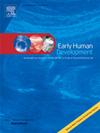剖宫产中中度早产至足月儿子宫外胎盘输注和脐带完整稳定的可行性研究
IF 2
3区 医学
Q2 OBSTETRICS & GYNECOLOGY
引用次数: 0
摘要
背景:虽然普遍推荐延迟脐带夹紧(DCC),但在剖宫产中实施困难。该研究的目的是测试子宫外胎盘输血(在脐带夹紧前输送胎盘)以促进脐带完整稳定对于中度早产至足月剖宫产婴儿及其母亲来说,是否可以作为DCC(≥1分钟)的可行且安全的替代方案。方法:本可行性研究纳入GA 320 ~ 423周、计划或紧急剖宫产的婴儿。主要结果为干预依从性。安全性指标为母亲失血量≥1000 ml或术后伤口感染的发生率,婴儿早期脐带夹紧(ECC)、低5分钟Apgar评分和体温过低的发生率。结果:干预组123对母婴,对照组158对母婴。123例中有121例成功完成干预。在产妇结局方面没有统计学上的显著差异。与历史对照组相比,干预组60秒前发生ECC (OR 0.07, CI (0.01-0.51), P = 0.009)和5分钟Apgar评分<;7 (P = 0.003)的婴儿明显减少。婴儿体温过低无显著差异。结论:子宫外胎盘输注可作为区域麻醉下剖宫产足月和近足月早产儿DCC的合理选择。该干预措施可能对低收入出生环境特别有用,缺铁/贫血患病率高,没有移动复苏设备。本文章由计算机程序翻译,如有差异,请以英文原文为准。
Extra-uterine placental transfusion and intact-cord stabilisation of moderately preterm to term infants in caesarean deliveries - A feasibility study with historical control (INTACT-2)
Background: Although delayed umbilical cord clamping (DCC) is universally recommended, implementation has been difficult in caesarean deliveries. The study objective was to test if extra-uterine placental transfusion (delivering the placenta before cord clamping) to facilitate intact-cord stabilisation could be a feasible and safe alternative to DCC (≥ 1 min) for moderately preterm to term infants with caesarean delivery in regional anaesthesia and their mothers. Methods: This feasibility study included infants with GA 320 to 423 weeks with planned or emergency caesarean delivery. Primary outcome was intervention compliance. Safety outcomes were prevalence of blood loss ≥1000 ml or postoperative wound infection in mothers, and prevalence of early cord clamping (ECC), low 5-min Apgar scores and hypothermia in infants. Results: We included 123 mother-infant pairs in the intervention group and 158 in the historical control group. The intervention was successfully completed in 121 of 123 cases. There were no statistically significant differences in maternal outcomes. Significantly less infants in the intervention group had ECC before 60 s (OR 0.07, CI (0.01–0.51), P = 0.009) and 5-min Apgar scores <7 (P = 0.003) compared to historical controls. There was no significant difference in infant hypothermia. Conclusion: Extra-uterine placental transfusion may be a reasonable alternative to DCC for term and near term preterm infants with caesarean delivery in regional anaesthesia. The intervention may be especially useful in low-income birth settings with high prevalence of iron deficiency/anaemia and no mobile resuscitation equipment.
求助全文
通过发布文献求助,成功后即可免费获取论文全文。
去求助
来源期刊

Early human development
医学-妇产科学
CiteScore
4.40
自引率
4.00%
发文量
100
审稿时长
46 days
期刊介绍:
Established as an authoritative, highly cited voice on early human development, Early Human Development provides a unique opportunity for researchers and clinicians to bridge the communication gap between disciplines. Creating a forum for the productive exchange of ideas concerning early human growth and development, the journal publishes original research and clinical papers with particular emphasis on the continuum between fetal life and the perinatal period; aspects of postnatal growth influenced by early events; and the safeguarding of the quality of human survival.
The first comprehensive and interdisciplinary journal in this area of growing importance, Early Human Development offers pertinent contributions to the following subject areas:
Fetology; perinatology; pediatrics; growth and development; obstetrics; reproduction and fertility; epidemiology; behavioural sciences; nutrition and metabolism; teratology; neurology; brain biology; developmental psychology and screening.
 求助内容:
求助内容: 应助结果提醒方式:
应助结果提醒方式:


